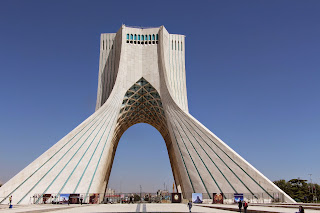 |
| Stained-glass windows of Masjed-e Nasir-al-Molk, Shiraz |
Is it safe?
 |
| Tehran's iconic Azaadi Tower |
Aren't all Iranians fiery-eyed and anti-American/Israeli?
 |
| UNESCO-listed Persepolis |
Granted, I witnessed two rallies against the US, Israel and Saudi Arabia (for the bombing campaign in Yemen), but these attracted small crowds of about 100 or 200 at most.
Here's another story: the first meal I had at a sandwich joint, I was asked if I'd like Pepsi or some other carbonated drink. It took me a while before I realised I was actually drinking a can of Pepsi (Coke is available too)! Some things, as they say, are worth way more than principles.
Should I really go to Iran? I don't want to be spending money in a country with a regime like that..
Oh don't worry about it. Your government is probably doing that already. Like I said, some things are worth more than principles.
Aren't all the women covered up in burqas?
 |
| Courtyard of a traditional house in Kashan |
Speaking of women..
If you're a guy and are introduced to a woman, shake her hand only if she offers it first. The same applies with family members.
 |
| Contemporary art exhibition, Tehran |
Women are required to wear a scarf and dress modestly, which means no tank tops, no spaghetti straps, no shorts/skirts. Loose pants and tops would be best, though I saw some Iranian women in relatively tight jeans. If in doubt, go with slightly loose bottoms. Same goes for the tops. Men too have to adhere to some rules: no tank tops, no shorts. T-shirts are fine. In fact, some Iranian men themselves have a thing for wearing tight tees to show off how hard they've worked in the gym.
 |
| Dome of Masjed-e Sheikh Lotfolla, Esfahan |
Citizens of most countries can obtain a visa on arrival (for a 2-week stay) unless otherwise stated. The cost depends on where you're coming from. For Singaporeans, it's 60 euros. When you arrive at Imam Khomeini International Airport in Tehran, go to the Foreign Affairs/Visa counter. They might ask you for a visa authorisation code, as I was. I just told them I was applying for a VOA and they gave me a form to fill. Once that's done, go to the bank adjacent to the counter and make payment for your visa. Then you have to go back to the visa counter and hand over your passport, the filled-up form and receipt from the bank. Make sure that you have the name and contact number of the hotel you're staying at. The officer may also ask for a mobile number of someone in Iran. If you don't have a friend in the country, try getting the mobile number of whoever it is you've liaised with for your hotel stay. Oh, and make sure you come with travel insurance. Then again if you don't, there's a counter right across from the visa office for you to make the purchase.
How do I get around?
 |
| Golestan Palace, Tehran |
Can I use my credit/debit cards in Iran?
No. They won't work due to the sanctions imposed on the country. So bring everything you need in cash (USD, Euros or UAE Dirhams). It also means that your bus, train and flight tickets have to be booked in Iran itself, unless you have a friend there who can do it for you before you get there.
How expensive is it?
Tourist sites will set you back by about 3-5 US dollars each, although Lonely Planet's 2012 edition claims otherwise. But if you look Iranian and manage to get a local ticket, you'd pay just about 50 cents per entry.
A latte costs about 2.50-3 US dollars, and lunch at a decent enough restaurant can set you back by at least 5-8 US dollars (depending on what you order). Mineral water is cheap though. So is public transport.
 |
| The garden at Naranjestan, Shiraz |
This is something that requires getting used to. The official currency is Rial, but you'll be quoted prices in Tomans. The difference is that Rials have an extra '0' behind (for example, 4,000 Tomans means you'll have to pay 40,000 Rials). Turns out the currency was changed to Rials by Reza Shah over 70 years ago, but Iranians continued being more comfortable and familiar with the Toman. The central bank has plans to revert to the use of Tomans. Until then, it'll be useful to know the difference. It'll save you the embarrassment of thinking your dinner was dirt cheap.
 |
| Masjed-e Shah, Esfahan |
Staying connected
Most cafes have wifi, so do the hotels. I usually had a pretty good signal. Do note though that Facebook is blocked, and access to Twitter is a bit patchy. If you absolutely must access Facebook, you'll have to do it via a proxy server (ask the locals).
You'll also need to get a local SIM card if you want to make calls/send SMSes (your home networks won't be available in Iran). For this, go to the Imam Khomeini metro station in Tehran and look for the mobile shop/centre. Take a queue number and wait. Don't forget your passport and the address of your hotel. Let the staff know if you need data, and make sure you check that it works before scooting off.
Read!
- The Ayatollah Begs To Differ: The Paradox of Modern Iran by Hooman Majd (highly recommended)
 |
| The abandoned village of Kharanaq |
- Days of God by James Buchan (details the lead up to the 1979 Revolution)
- Shah of Shahs by Ryszard Kapuscinski (a profile of the last Shah of Iran)
- Poetry by Hafez (They say all Iranian homes have two books at home: one book of poetry by Hafez and the Quran)
- Poetry by Rumi, Sa'di, Khayyam